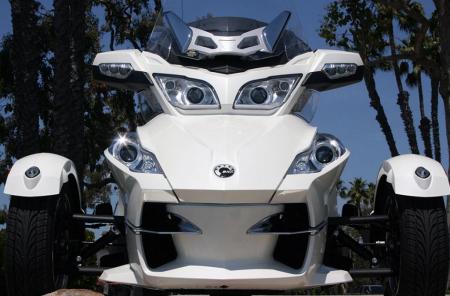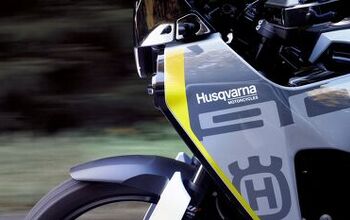2011 Can-Am Spyder RT Limited Review [Video] - Motorcycle.com
Born to Be Wild, the popular theme song for recalcitrant bikers, is a ditty to which I'll often sing along when the mood strikes. On this particular day while riding the Can-Am Spyder RT Limited, the rock ’n’ roll battle cry couldn't have been more discordant.
Sure, I was exhibiting anarchy — flouting the law by riding 85 mph in a posted 65 mph zone — but considering the architecture of the machine and endless quizzical looks the Spyder inspires, I felt a one-hit-wonder such as Der Kommissar, the little-understood but extremely popular tune from the Austrian band Falco, was a more fitting motif. Pressing "scan" on the Spyder's bar-mounted switchgear, I left Steppenwolf for more appropriate background muzak.
That no one can hear my radio selection while thrumming down the Harbor Freeway isn’t the point; it’s a matter of self-perception, and right now I’m thoroughly confused. The Spyder’s expansive use of bodywork and capaciousness (enough to make a Wing Dinger jealous, 155 liters vs. 147 liters) isn’t the cause of my mental trauma, nor is it the RT Limited’s abundance of electronic paraphernalia including traction control, anti-lock brakes, stability control, cruise control, etc.
What has me so confounded are those two leading wheels! Is this thing a motorcycle? Am I correct addressing it as a bike? It’s not a traditional trike. It has handlebars and a twist grip, but no clutch lever and only a foot brake. I can’t lane share, and it takes an entire parking space, but it’s not a car. Its handling reminds me more of riding an ATV than either of the two. What is this bastardized contraption that doesn’t fit into an established two-wheel genus meant to keep moto-journalists from thinking too hard?
Whatever this ambiguous motorcycle thing is, at least I’m riding the top-of-the-line version. Yep, only the best for us, even if the Limited edition stands apart from the standard RT-S by way of minimal enhancements including special paint (pearl white), an embroidered seat, semi-rigid bags for the storage compartments, an included travel cover and a Garmin Zumo touchscreen GPS system.
Gotta admit, though, the GPS system is an incredibly useful addition. Mounted in an easily visible area between the handlebars, the Garmin integrates into the Spyder’s audio system whenever the device is snapped into position. The unit is also Bluetooth capable and it took only a matter of seconds to for it to establish communication with my Bluetooth-enabled Schuberth C3 helmet, delivering driving instructions directly to my ears via the speakers within the helmet.
Before I get carried away with details, however, let’s remain focused on the Spyder’s atypical quality — the ride. Having minimal previous seat time on a machine with dual front wheels and a solo rear, it’s immediately clear on the first freeway on-ramp that no matter how hard I try, Can-Am Spyders do not lean into a corners. It feels natural to lean your torso into the corner, but its affect on the Spyder is negligible. The Spyder’s electronics package maintains the machine’s composure, minimizing both the risk and, to some degree, fun.
The Spyder’s stability control (VSS), ABS and traction control (TCS) conspire to keep a rider safe and in command of the machine at all times. The electronics function in the background without interference until you’re compelled to get a little aggressive, which most motorcyclists are want to do on occasion. The VSS ensures the rear wheel stays inline with the travel of the front wheels, while the TCS reduces engine power until traction is regained.
Exiting a corner at speed you can twist as much throttle as you like, but no propulsion is applied unless the Can-Am’s ECU determines the Spyder is traveling straight enough to keep things from getting crazy. I did overwhelm the Spyder’s TCS a few times in extremely gravelly areas but only for a limited duration. Where I felt the systems being taxed was during a photo session on a particularly bumpy right-hander. Exiting the corner both the front and rear ends were bouncing around, challenging the capacity of the two electronic systems but at no time did I feel at risk of losing control.
As for the ABS, I wouldn’t have it any other way. Mashing the foot-operated brake pedal applies pressure to all three disc brakes (two front, one rear) and hauls the nearly 1,000-pound machine to a quick stop.
The electronic component an RT Limited rider can manipulate at will is the vehicle’s SE5 semi-automatic transmission — semi-automatic because all it requires of the rider are the upshifts; the SE5 is capable of downshifting of its own accord. The automatic downshifts happen at a very low revs (around 2,500), so to keep the 998cc V-Twin engine spinning in its sweet spot, I’d often use my index finger to force an earlier downshift (upshifts are operated by the thumb). The shifting isn’t Ferrari 458-fast, but it does function fluidly. Putting the Spyder into reverse requires depressing a special “R” button and downshifting. My only complaint is the paddles crowd your left hand, forcing it to the end of the handlebar or beyond in order to comfortably operate the shifting.
In addition to selecting gears, the left handlebar also incorporates the selection of radio stations and controlling audio levels as well as standard operations including blinkers, high/low headlight beam and horn, and the height of the electronically adjustable windshield. On the right bar you’ll find the cruise control.
In its lowest setting the top of the windshield remains below my line of sight and puts my shoulders and helmet into direct airflow; at its highest setting the top of the windshield is above my line of sight and the only wind I can feel is a slight buffeting on the back of my helmet.
Engaging the cruise control is a simple matter of depressing the cruise control button with your right thumb. By allowing a rider to relax his right hand to shake out any numbness and reinvigorate blood flow, this function isn’t a luxury, it’s a necessity as any long-distance rider will corroborate.
Two other components of this rolling electrical menagerie are the electronically adjustable rear suspension and dynamic power steering. Located above the centrally-mounted glovebox and below the Garmin unit is a row of toggle switches. Between the parking brake and fog lights you’ll find a switch for increasing and decreasing the preload of the Spyder’s air-supported rear shock. I kept the setting on high as the Spyder seemed to want to wander left and right when the preload was lessened.
The dynamic power steering is supported by an electronic motor that bases its amount of assist on acceleration, steering angle and vehicle speed. The system really works because at no time, even at walking speeds, do I recall putting effort into turning the Spyder. Considering the vehicle’s size, weight and the fact that there are two wheels up front, the Spyder exhibits a tight turning radius, good for close-quarter maneuvers, parallel parking and other drills requiring dexterity.
The Can-Am Spyder’s passenger has his/her own set of push-button electronics including heated handgrips and controls for adjusting radio volume and channel selection.
Orchestrating this gamut of charged particles is the Spyder’s information screen, its color interface located between the analog speedo and tachometer. Like a mini-computer, the system requires booting-up when activated, but unlike other motorcycles the Spyder seems to require additional time before operation can commence. Unless you’re constantly starting and stopping this will likely go unnoticed, but it can be a trifle annoying when you’re in a hurry.
I briefly mentioned storage earlier, but it deserves a second round because the Spyder RT has acres of it. Full-face helmets will fit into the Spyder’s saddlebags while taller items will find the RT’s front trunk obliging. All compartments are lockable, but only the Limited comes with semi-rigid travel bags included, a $780 retail value. If more storage is required, Can-Am offers the RT-622 Trailer providing an additional 622 liters of storage (enough for two sets of golf clubs touts Can-Am) bringing the Spyder’s total capacity to 777 liters.
Is the Spyder RT Limited comfortable? Let me put it this way, if it’s legal to enter in the Iron Butt rally it would be cheating. I’d go as far to say it’s the most comfortable motorcycle I’ve ridden, but that statement would be inappropriate considering the Spyder’s three-wheel architecture. Nonetheless, from seat material to seating position, it was hard to fault, and that goes for both rider and passenger.
So if you’re in the market for a new touring rig but Gold Wings and BMW K1600s seem like a lot of machine to keep upright and balanced on two wheels, the Can-Am Spyder Limited, or the standard (read less expensive) RT model, is worth your attention as a viable option. But it ain’t cheap, with an MSRP of $28,099.
Having spent the better part of a month zig-zagging the Spyder Limited around Southern California, and sleepless nights trying to wrangle from my brain a cogent interpretation of the Spyder, I’ve come to the conclusion that the Can-Am Spyder is a horse of a different color, which is really what being a rebel is all about.
Related Reading
2010 Can-Am Spyder RT Model Intro
2009 Can-Am Spyder SE5 Review
2008 Can-Am Spyder Review
2008 Can-Am Spyder Test
CanAmSpyderForums.com
More by Tom Roderick



































Comments
Join the conversation